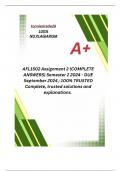, QUESTION 1 (a) Give a brief explanation of the term ‘conflict’ as found in a
modern novel or drama. (10) (b) The structure of an essay may be divided into
3 parts. Identify these 3 parts and then give a brief discussion of each part. (9)
(c) Read the following poem and answer the questions: THE SECRET OF
LIFE The secret of life is nice tasting, It is inside you in the heart, Also in a
closed book, When you open it you read it, You will find everything of life. On
a page that is starting to be written on, Life is like a lot of diviners. Enjoyment
and pain walk together, Just like darkness is the brother of the night; And light
is the brother of the afternoon. (i) Identify and rewrite any 2 poetic devices that
the poet has used in the poem. (4) (ii) In what way does the poem above differ
from a narrative text like a short story? Give only one different. (2) /25/
QUESTION 1
(a) Brief Explanation of ‘Conflict’ in a Modern Novel or Drama (10)
Conflict is a central element in modern literature, referring to the struggle between opposing
forces that drives the narrative forward. In a novel or drama, conflict can manifest in various
forms, such as internal (psychological struggles within a character) or external (between
characters, society, or nature). For example, in Chimamanda Ngozi Adichie's Half of a Yellow
Sun, the conflict revolves around the Nigerian Civil War, showcasing not only the external battle
between different factions but also the internal conflicts experienced by characters as they
navigate love, loyalty, and survival amid chaos. This struggle propels character development and
themes, making conflict essential for a compelling narrative.
(b) Structure of an Essay (9)
An essay typically consists of three main parts:
1. Introduction: This is the opening section of the essay, where the topic is introduced, and
a thesis statement is presented. The introduction sets the tone for the entire essay,
outlining the main argument or purpose and engaging the reader's interest.
2. Body: The body is the core of the essay, usually comprising multiple paragraphs that
elaborate on the thesis. Each paragraph should focus on a single point, providing
evidence, examples, and analysis to support the main argument. The body should be
logically organized, often following a structure that progresses from the general to the
specific or in order of importance.
3. Conclusion: The conclusion wraps up the essay by summarizing the main points and
reiterating the thesis in light of the arguments presented. It should provide closure,
leaving the reader with a final thought or reflection on the topic, emphasizing its
significance or implications.




